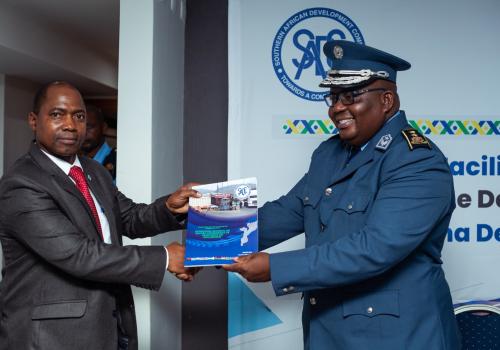The geographic location of Mozambique is attractive for international movement of people and goods but exerts pressure on all entities operating at borders. This therefore calls for effective and efficient coordination between public bodies and the private sector at the borders to improve fiscal control, public security, as well as facilitating trade and migratory transit.
This was said by Mr. Fernando Alage, Deputy Director General of Customs, Mozambique Revenue Authority, when he opened a workshop on the country’s Coordinated Border Management (CBM) National Strategy held in Maputo from 27th March to 30th March 2023. The workshop was aimed to enhance coordination and cooperation among Government ministries, departments and agencies, as well as representatives of private sector organisations that have a role in facilitating cross-border trade and the clearance of travelers.
At the end of the workshop, the Southern African Development Community (SADC) Secretariat handed over the CBM National Strategy document to Mozambique, which became the first SADC Member State to develop the strategy which is supported by the European Union (EU)-funded Trade Facilitation Programme (TFP) and is implemented by the Secretariat. The TFP seeks to ensure that trade flows within SADC Region and with the outside world are increased along the North-South Corridor NSC, supports the implementation of the World Trade Organisation Trade Facilitation Agreement and the SADC CBM Guidelines on selected border posts along the corridor.
Mozambique’s CBM plan seeks to strengthen the coordination and cooperation mechanisms among Government agencies, and between Mozambique and SADC Member States, on clearance of goods, means of conveyance, and people at the border posts.
Mr Alage said the strategy is part of a set of trade facilitation measures recommended by international organisations, to which the country is a signatory, aimed at allowing greater organisation, speed and less bureaucracy in trade, and constitutes an essential tool in the scope of regional and continental integration, particularly in the SADC Free Trade Area (FTA).
The strategy presents two perspectives, namely a horizontal perspective which shares information and procedures between all institutions exercising procedural compliance control at borders; and a vertical perspective which translates into the harmonisation and sharing of the same procedures and policies among State officials, from top to bottom and vice versa.
Speaking at the same occasion, Mr. Alcides Monteiro, Senior Officer-Customs, Directorate of Finance, Investment and Customs in the SADC Secretariat, encouraged stakeholders to effectively implement the CBM National Strategy in order to improve the business environment, attract Foreign Direct Investment (FDI) and increase trade flows within the SADC Region along the North-South Corridor.
Implementation of the CBM concept forms part of the activities contained in the TFP which was designed to support the consolidation of the SADC FTA, to support the implementation of SADC Industrialisation Strategy and Roadmap (2015-2063) and value chains as part of SADC Regional integration agenda. The FTA, whose implementation began in 2008 when 12 Member States achieved 85 percent liberalisation of their tariff lines, contributed significantly to the increase in trade in the Region. Current statistics indicate that intra-regional trade stands at 20 percent and there are indications that this figure could increase in the short term with the introduction of the Industrialisation Strategy and Roadmap focusing on value chains.
Mr Monteiro said to consolidate the FTA, the Ministerial Taskforce for Regional Integration identified, among several measures, the removal of non-tariff barriers, effective implementation of trade facilitation measures, and the accession of Member States that are not yet part of it.
Implementation of the CBM concept in Mozambique is expected to contribute to the improvement of the business environment and attract FDI that will also eventually contribute to the transition of the economies of scale.
Speaking after receiving the CBM Strategy document and in his workshop closing remarks, Mr Alage expressed appreciation and gratitude to the SADC Secretariat for its assistance in designing the plan.
“The National Strategy for Coordinated Border Management, which we have just received today, is part of a set of trade facilitation measures recommended by international organisations to which Mozambique is a signatory, aiming at greater organisation, speed and less bureaucracy in commercial exchanges with neighbouring States and is also an essential mechanism or tool in the scope of regional and continental integration, particularly in the SADC Free Trade Area,” he said.
“It remains for us all to continue to engage in efforts for the practical implementation of the Strategy that we have just witnessed the reception, in favour of the development of Mozambique, the region, the continent and the entire world.”

